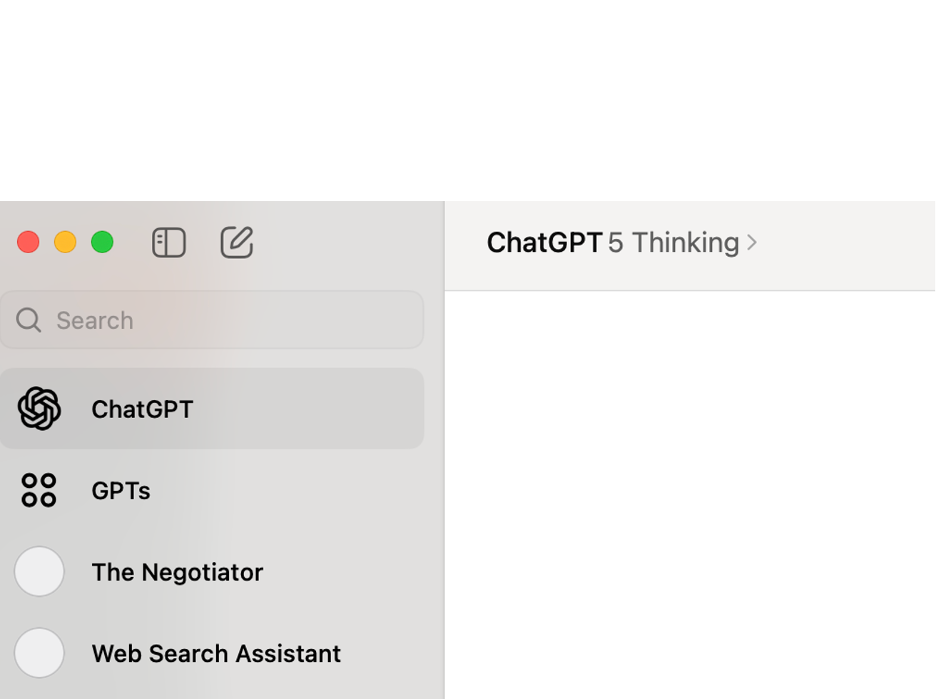ChatGPT 4 vs 5: The Real Benefits of ChatGPT 5
The International Risk Business Leaders Can’t Ignore in OpenAI’s New ChatGPT 5 Release
When OpenAI rolled out GPT-5 to all ChatGPT users on 07 August, it wasn’t just another AI press cycle; it was a board-level signal. The model now sits in front of roughly 700 million weekly users, with OpenAI openly pitching it as an expert-grade system for coding, writing, finance, and health. For senior business executives asking what’s materially different in this new release, the answer is both straightforward and sobering: ChatGPT 5 is better, it is more capable, more coherent, more enterprise-ready, and with these exciting opportunities, the upgrade also exposes a sharper set of international risk considerations around trust, economics, and strategic dependence.
OpenAI’s CEO Sam Altman framed the leap to Chat GPT 5 succinctly yesterday. In his words, GPT 5 is the first time it “feels like you can ask a legitimate expert, a PhD-level expert in anything.” That’s not marketing fluff; it’s the point business leaders need to understand. If your teams can reliably treat ChatGPT 5 like a rotating bench of specialists on demand, the productivity and decision-cycle gains are obvious. But “expert” is a strong claim and it must be tested, governed, and integrated with testing. Expert isn’t output, it is experience plus accountability. Our Host, Dominic Bowen has earned the title expert. He has the experience, delivered the outcomes, and is accountable. ChatGPT 5 isn’t that kind of expert. GPT 5 is an expert witness. Use it to accelerate insight but make sure you keep a human in the accountability chair.
What changes with GPT 5

ChatGPT 5 is more than a fast chatbot. OpenAI has effectively collapsed its model chooser inside ChatGPT and added a router that silently escalates to reasoning modes on harder prompts, sometimes after you tell it to “think hard.” In practice, your users see one model that feels consistent while the system decides when to allocate extra compute for tougher tasks. This matters operationally: fewer fiddly decisions by end users, and more predictable outcomes for standard workflows. The CEO of OpenAI, Sam Altman himself called the old picker a “very confusing mess,” a frank admission that aligns with enterprise feedback on cognitive overhead in tooling. Underlying the user experience, OpenAI has also shipped mini and nano variants for developers, plus usage caps for free tiers, and higher allowances for paid tiers.
For CIOs who live in documents and code, the context window jump to a reported ~256k tokens enables longer briefs, more in-line evidence, and richer codebases without dropping context mid-stream. During OpenAI’s press demos, the team generated a working language-learning web app in near real time, an anecdote that neatly illustrates why “software on demand” is becoming the meme for this cycle. These demonstrations aren’t proof of generalized transformation, but they are clear indicators of the direction of travel: rapid prototyping, compressed iteration loops, and platformized innovation.
Where the value with LLMs shows up: Real benefits of ChatGPT for Enterprises
The “big four” hyperscalers: Amazon (AWS), Microsoft (Azure), Alphabet/Google Cloud, and Meta, are pouring hundreds of billions into AI-ready data centers, GPUs, land, and power. That’s a fixed-cost arms race that only pays if utilization soars. OpenAI’s ChatGPT 5 fits that logic: a “good-enough, everywhere” default that quietly routes routine work to efficient inference and escalates to heavier reasoning only when needed. For buyers, the value is not the press-release speed bump; it’s the operational reality that more of your day-to-day drafting, coding, and analysis can be done reliably by the baseline model, with the Thinking variants reserved for complex edge cases. If utilization rises on tasks that actually matter to your P&L, the economics work for OpenAI and for you.
Translating that into value creation is clear for managers: migrate specific workflows and measure impact. Firstly, make “AI writes, humans sign” the base of all new processes. There are so many reasonable use cases for your business today. Think about RFPs. Today a mid-market vendor might spend 60 hours per bid across sales, product, legal, and finance. With ChatGPT 5, you seed it with your last three winning proposals, approved pricing guardrails, compliance requirements, and product specs. ChatGPT 5 then drafts a client-specific response in minutes. The team spends the morning editing and signing off. That is at least 40 hours saved per bid. If you run 100 bids a year, that’s roughly 4,000 hours back of team capacity, plus faster submission times that immediately improve your business. That is where value shows up: shorter cycles, cleaner handovers from computer to people, and more success without adding headcount.
Dominic Bowen: “GPT 5’s launch is a pivotal moment for AI-driven efficiency, and also for boardroom dynamics. This should force leadership teams to think deeply about how AI accelerates strategy without outpacing governance. You need to be ready, because your competitors certainly are.”
The uncomfortable math behind ChatGPT 4 versus 5
The temptation is to benchmark ChatGPT 4 versus 5 like phones: faster chip, better camera. Resist that. The strategic question is whether ChatGPT 5 is reliable enough to move real work (code, drafts, analyses, reporting) without multiplying rework or reputational risk. Our early commentary is cautionary. As columnist Noah Smith put it, “Business spending on AI has been pretty weak… consumer spending isn’t going to be nearly enough” to justify the massive infrastructure build-out. The translation for the C-suite is that the ROI burden now sits squarely on enterprise outcomes.

Even Altman is deliberately sober about the ceiling. “This is not a model that continuously learns as it’s deployed,” he admitted when asked about the AGI narrative. The Guardian characterized GPT 5 as a “significant step” that is still “missing something quite important”. This is precisely the nuance your risk committee needs to hear. GPT 5 is not a self-improving colleague; it’s a powerful but static tool that changes only when OpenAI ships a new version. That means you manage it like any other release: pin the model your workflow depends on, canary-test every upgrade, and keep a rollback path if you are not satisfied with the results. Treating it as autonomous is how you end up outsourcing QA to your customers. The leadership move is to decide, per workflow, where GPT 5 may draft and where only humans may decide and to publish.
For operators, translate that stance into numbers you can defend in a budget meeting. Set a reliability bar for each use case and track three things every month: time-to-complete (cycle time per unit of work), first-pass yield (how often the draft is approved without rework), and defect cost (what an error actually costs you in refunds, rebates, or reputation). Scale GPT 5 across your business only where those metrics beat your current baseline for four consecutive weeks; everywhere else, keep it as an assistant, not an owner. Control the downside, bank the upside, and convert this headline into better EBITDA.
ChatGPT 5 is better but it is not alone
The benefits of ChatGPT 5 land in a crowded field. GPT 5 is a meaningful evolution, but not as wide-reaching as many had hoped for. Benchmarks show real step-ups in coding and reasoning, but rivals will claim parity or wins in specific tests. That’s healthy and it keeps improvements coming. The bigger story is OpenAI’s distribution advantage, which now totals hundreds of millions of users, strong enterprise mindshare, and a product surface that increasingly routes users to the “right” model for the job. This combination of reach plus orchestration is strategically potent, provided the economics hold.
On economics, perspective helps. OpenAI’s rumored valuation swing from $300 bn to $500 billion depends on enterprise traction, not consumer chat. Research suggests that 34 percent enterprises have paid AI usage today. Conversely, 42 percent of companies have already scrapped AI deployments this year due to early struggles in AI rollouts. If that’s anywhere close to your reality, your transformation plan should emphasize fewer, bigger, better deployments. We encourage measurable lifts in two or three core processes instead of attempts to deliver immediate and diffuse use over your entire enterprise.
What great looks like in the next 12 months and what are the risks
The organisations that win with ChatGPT 5 will treat it like a capability platform, not a toy. The winning organisations will codify prompts into templates, bind the model to source-of-truth data, and build guardrails that turn subjective creativity into repeatable processes. For your business, scale the rollout of ChatGPT 5 only when the operating metrics beat your current baseline for at least four consecutive weeks. That’s how you move from experimentation to an operating model that is likely to succeed.

On misinformation and hallucinations, OpenAI’s safety team says they spent 5,000+ hours of red-teaming and tuned GPT-5 to “give as helpful an answer as possible, but within the constraints of remaining safe.” That mitigates risk; it doesn’t eliminate it. Treat customer-facing copy as drafts, not gospel, mandate evidence-linking for claims, and keep domain experts in the loop on anything regulated or reputationally sensitive. The simple policy “AI writes, humans sign” is still the gold line and unlikely to change in the year ahead.
Dominic Bowen: “GPT 5 promises clarity and speed, but the real test for business leaders is whether they can integrate its capabilities without eroding the rigour of existing risk management. If your risk committee isnt already discussing the implications, they are significantly behind.”
Bottom line on GPT 5 for business leaders
The benefits of ChatGPT 5 are tangible: stronger reasoning, better long-form writing, more robust coding assistance, and a user experience that hides the complexity of model choices behind a router that does the heavy lifting. The risks are equally tangible: persistent accuracy limits, human-factor backlash when familiar models shift, and dependency on a fast-moving supplier with global priorities that may not match yours.
If you lead a multinational company, the right posture is curious, decisive, and disciplined. Use ChatGPT 5 aggressively where the economics and controls are clear and refuse it where the accuracy bar is unforgiving. Measure everything.
The next quarter decides whether ChatGPT 5 is theatre or EBITDA. Pick two workflows that touch revenue or cash (RFPs and customer support are low-drama, high-yield), set a target, assign a single owner with budget authority, and review the numbers every week. And publish one page document for all staff that says where AI drafts and where humans decide. This isn’t about being “AI-first”; it’s about being margin-first while the OpenAI “new release” arms race plays out in the background.
AI won’t replace your business, but a rival using AI will replace your competitive advantage. The leaders who win won’t be the ones with the glossiest “AI strategy” deck; they will be the ones who can point to a line on the P&L and say, “That moved because we used ChatGPT 5 there, and we contained the risk appropriately.” Decide, ship, measure, and cut what doesn’t work. Everything else is noise.



